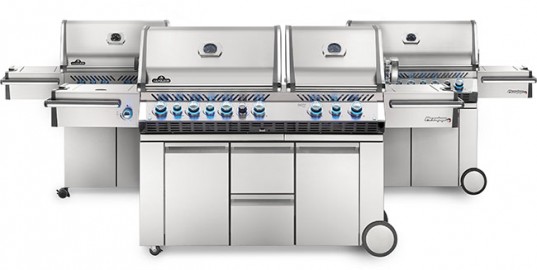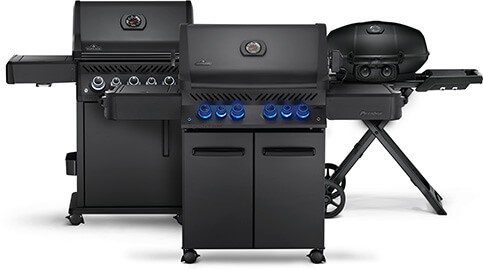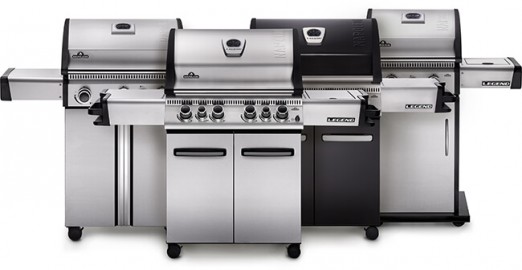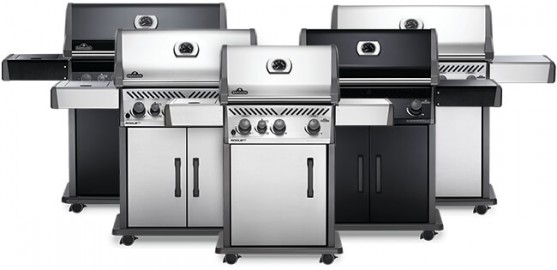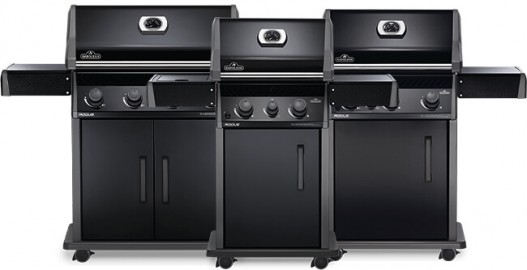Chrome accents and stainless steel construction, the Prestige PRO Series comes with features that will turn any chef into a PRO.
Gas Grills
You'll never want to cook indoors again once you experience a Napoleon Gas Grill.
High quality stainless steel and built to last.
The epitome of summer
Grilling epitomizes the essence of summer, evoking memories of sunny days and the appetizing aroma of food sizzling away. It’s a cherished ritual, uniting people in moments of warmth and camaraderie. BBQ grilling offers many options for beginners and enthusiasts alike, and the different grilling methods and tools make it a fun and exciting experience.
Up to 10 burners
Up to 123K BTU
Infrared SIZZLE ZONE™ Burner
Rear Infrared Rotisserie Burner
RGB Spectrum Control Knobs
Wood Chips Smoker Tray
9.5mm Iconic WAVE™ Cooking Grids
Interior Grill Lights
Up to 6 Burners
Up to 99K BTU
Infrared SIZZLE ZONE™ Burner
Rear Infrared Rotisserie Burner
NIGHT LIGHT™ Control Knobs with SafetyGlow
7.5mm Iconic WAVE™ Cooking Grids
Folding Side Shelves
Up to 5 Burners
Up to 57K BTU
Infrared SIZZLE ZONE™ Burner
Backlit Control Knobs
Folding Side Shelves
Up to 7 Burners
Up to 88.5K BTU
Infrared SIZZLE ZONE™ Burner
Rear Infrared Rotisserie Burner
Backlit Control Knobs
Folding Side Shelf
Up to 6 Burners
Up to 69K BTU
Infrared SIZZLE ZONE™ Burner
Folding Side Shelves
Up to 4 Burners
Up to 14 kw
Folding Side Shelves
Up to 38K BTU
Porcelain Enameled
Sear Plates
Iconic Wave Grids
Cross Over Lighting
Up to 4 Burners
Up to 38K BTU
Folding Side Shelves
Is Natural Gas or Propane Better for Grilling?
Gas and propane grills, at their core, both rely on fuel to provide heat, but they source this fuel differently. Gas grills are connected to natural gas lines and offer the convenience of a consistent fuel supply, often being cost-effective in the long run. On the other hand, propane grills utilize portable propane tanks, making them more versatile in terms of location and mobility but requiring periodic tank replacements. While both can deliver a delicious grilled meal, your choice might hinge on factors like portability, fuel cost, and setup preferences.
Natural Gas
When it comes to natural gas grilling, there are several distinct advantages. First, a BBQ gas grill can be more cost-effective than propane in the long run. This is a boon for regular grillers, who will see cumulative savings over time. For homes connected to a natural gas line, there’s the benefit of a continuous supply. This eliminates the periodic need to refill or replace tanks, offering uninterrupted grilling sessions. If you are concerned about environmental impact, you might lean towards natural gas as it burns cleaner than propane, reducing emissions. The convenience factor is also undeniable. With a fixed connection, there’s no juggling of tanks—just ignite the BBQ gas grill whenever you’re in the mood for a BBQ.
Propane
Propane’s standout feature is portability. Grills that rely on propane are more mobile because of their detachable tanks. Regarding heating performance, propane often delivers a higher BTU rating, allowing it to achieve scorching temperatures faster than its natural gas. For those concerned about availability, propane tanks are easily accessible at various retail locations. And when it comes to setting up, propane grills are hassle-free, with no need for intricate installations or fixed lines.
But propane grilling does come with its own set of considerations. The periodic need to refill or exchange tanks means an added task on your to-do list. Over extended periods, the costs associated with these refills can surpass those of natural gas. Safety and storage are also paramount. Propane tanks need secure storage and routine inspections for potential leaks, and they occupy additional space.
Some enthusiasts believe that propane grills impart a slightly different flavor compared to natural BBQ gas grills. This is because, when burned, propane can have a faint taste and aroma. However, this difference is subtle, and many casual grillers might not even notice it. It’s worth noting that the smoky flavor commonly associated with grilling predominantly comes from the drippings and fats vaporizing on the hot grates and burners rather than the fuel itself.
A common question is whether propane can be used on natural gas grills or vice versa. The answer is no. A BBQ gas grill is specifically designed for a particular type of gas to ensure optimal fuel consumption and performance. Using the wrong gas can result in subpar grilling results.
Deciding between natural gas and propane is a matter of personal preference. Both gas types offer identical flavor and heat quality, especially with brands like Napoleon that optimize grills for either fuel type.
How Many Years Does a Gas Grill Last?
“How long will my BBQ gas grill last?” is a frequently asked question among those hunting for gas grills on sale. The lifespan of a BBQ gas grill isn’t set in stone—it’s primarily determined by the specific model you have and the care it receives.
Gas grills and their components will experience wear and tear. Your grill can serve you well depending on the quality of your BBQ gas grill, the frequency of usage, your cleaning routine, and overall maintenance. The way you use your BBQ gas grill can also influence its longevity. A standard part might last at least two years, but with higher-quality gas grills and diligent care, certain parts can last as long as 10-15 years.
Maintaining the pristine condition and functionality of your grill is crucial for both its lifespan and the quality of your BBQ. It’s best to do a deep cleaning of your grill at the close of each grilling season. For those who enjoy grilling throughout the year, a biannual cleaning, roughly every six months, is recommended. Look out for grease buildup, rust, or any signs of wear. Regular checks can prevent minor issues from turning into bigger problems. After cleaning, protect your grill from the elements using a grill cover. This helps prevent rust and keeps it clean for your next BBQ session.
Over time, as parts deteriorate, you might find the performance of your gas grill dwindling. However, most worn parts don’t warrant an entire grill replacement. In fact, many of them can be replaced with relative ease. Burners are one of the most frequently replaced parts on a grill. They can rust or get clogged, affecting their performance. Replace them when they show signs of heavy rusting or if they have holes that affect flame distribution. If your BBQ gas grill doesn’t light up as it should, the ignition system might be the culprit. Ensure the system is clean and free from debris. If problems persist, consider replacing the igniter, which is usually a straightforward process. Identifying and replacing the problematic component will allow you to enjoy your BBQ gas grill for many years.
What is the Best Grill to Buy Today?
Napoleon is a hallmark of North American grilling excellence, consistently delivering innovative, high-quality gas grills that offer superb value. Our cutting-edge designs stand out in the grilling industry. Features such as Napoleon’s exclusive “lift-ease” lid ensure effortless opening and closing, while the foldable shelves optimize space, making storage a cinch. Moreover, with the Jetfire ignition, which boasts a flamethrower starter, grilling becomes a seamless experience.
One of the standout features of Napoleon grills is their distinctive wave-design grates. Not only do they ensure even heat distribution, but they also prevent tiny bits of food from slipping through and disrupting the flames. Plus, for those who appreciate aesthetics in their grilled foods, this unique design guarantees impeccable sear marks on your dishes.
In terms of longevity and durability, Napoleon grills are unparalleled. Crafted from robust stainless steel, our grills are an investment designed to serve you for years. And, with the brand’s reliable warranty options, it’s evident that Napoleon gas grills are constructed with longevity in mind.
Napoleon has solidified its reputation as one of the top gas grills on sale on the market by offering high-end products that seamlessly blend innovative features with top-notch quality and construction. Extended warranties and unmatched customer service further demonstrate our dedication, allowing us to stand out in a cutthroat market.
Distinctive Features of Napoleon Gas Grills
Heating Capabilities: Not only do Napoleon grills feature burners with impressive heat output, but they also typically include extra burners. This provides enhanced heating and versatility during the grilling process. Despite the expansive cooking area, the concentration of heat per unit area remains high, ensuring efficient and swift cooking. Napoleon’s Jetfire ignition system outperforms many of its counterparts in terms of reliability and durability.
Sleek Design: Napoleon prioritizes aesthetics along with functionality. Unlike many competitors, Napoleon grills conceal their gas tanks within the unit, offering a neater appearance. Our grills often feature at least one retractable side table, adding to their convenience and compactness. The lid design of Napoleon grills deserves special mention. Our dual-piece lids are better at retaining heat and offer superior wind resistance.
Smart Ignition System: One of the standout features of Napoleon grills is the connected burner system. Should a burner extinguish unexpectedly, it’s designed to reignite automatically, reducing the need for constant monitoring and ensuring a smooth grilling experience.
Napoleon gas grills elevate the art of grilling and ensure durability and performance every time. For those seeking the pinnacle of outdoor cooking, Napoleon is a testament to unmatched excellence and is one of the best gas grills on sale in the marketplace today.
More FAQs About Gas Grills
How to Use a Gas Grill?
First, check the grill’s fuel supply. Make sure you have enough propane gas to fire up your grill. Turn the gas valve on by twisting the knob located near the fuel tank counterclockwise. Be sure to open it slowly and all the way.
Next, ignite the grill’s burners. Make sure all the burner knobs are in the “off” position, then select the burner you want to ignite and turn its knob to the “ignite” or “start” position. Press the ignition button until the flame appears. If your grill doesn’t have an ignition button, you’ll need to light the burners with a long-reach lighter.
After you have ignited the grill’s burners, wait a few minutes for the grill to heat up. This will give your grates time to get hot enough to sear the food properly. Turn all the burners to the maximum heat setting and let the grill preheat for about 15 minutes. This is an essential step that will make sure your food is cooked thoroughly.
Once your grill is heated, it’s time to start grilling. Arrange your food on the grill grates, then close the grill’s lid. This will keep the heat inside the grill and cook your food evenly. Monitor the temperature of the grill and make sure it stays at the level required to cook the food properly.
While your food is cooking, make sure you don’t lift the grill lid too often, as it can slow down the cooking process and alter the temperature inside the grill. Once your food is cooked, use tongs or a spatula to remove it from the grill and serve it up to your guests.
Finally, once you’re done grilling, turn off all the burner knobs and then close the gas valve. Let your grill cool down for about 10-15 minutes before covering it up and putting it away.
How to Clean a Gas Grill?
The first step in cleaning your gas grill is to make sure it has completely cooled down. Never try to clean a hot grill, as this can be extremely dangerous. Once it has cooled, remove the grates and set them aside.
Next, grab a wire brush and use it to scrub the inside of the grill to remove any excess food, debris or grease that has built up. Be sure to clean both the burner covers and the area surrounding them. Use a towel or brush to wipe away any loose debris.
Now it’s time to clean the grates. Take a good look at them to assess how dirty they are. If they’re really caked with food debris, you may need to let them soak for a few minutes before cleaning. You can do this by placing them in a mixture of hot water and dish soap.
Once they’re ready, scrub them clean with a wire brush, using long strokes. Then rinse the grates clean with warm water and pat them dry.
Finally, take a clean towel or rag and wipe down the exterior of the grill, making sure to remove any dirt, dust or fingerprints that may have accumulated. If there is any remaining grease on the exterior, you can use a degreaser or baking soda to clean it off.
Remember, keeping your gas grill clean will help it perform better and last longer. A well-maintained grill is a happy grill!
How to Start a Gas Grill?
Grilling is a fantastic way to cook delicious healthy meals while spending time outdoors with loved ones. To start your gas grill, here is what you need to do:
- Read the Manual - Before firing up your grill, it’s crucial to familiarize yourself with the instructions. This includes assembling your grill correctly and how to connect the propane gas tank. Every grill is different, so make sure to read the manual to avoid any problems.
- Check the Gas Tank - Check your propane gas tank to make sure that it has enough gas to power your grill. You don’t want to run out of gas mid-way through your cooking!
- Open the Lid - Lift the grill lid and open all the vents. This allows air to circulate inside the grill and keeps the flames burning.
- Turn On the Gas - Turn the gas valve on by twisting the knob located near the fuel tank counterclockwise. Be sure to open it slowly and all the way.
- Turn the Burners On - Depending on your grill; the ignition process may differ. For most gas grills, turn the knob on the burner to “on.” Turn the dial and hold the ignition button for a few seconds. This will light up the grill’s burner.
- Preheat the Grill - It’s important to preheat the grill for at least 10-15 minutes. This process will help kill off any bacteria on the grill grates and prepare the grill for cooking. Preheating the grill also ensures that the temperature inside the grill is constant, giving you better control of your cooking.
- Close the Lid - After preheating, close the lid to trap the heat inside. The heat from the grill will circulate and cook the food.
- Adjust the Temperature - The last step is to adjust the temperature of the grill according to your desired level of cooking. If your grill has multiple burners, you can use one side for high heat and the other for lower heat, depending on the food you’re cooking.
Remember, safety should always come first when grilling. Keep a fire extinguisher nearby, never leave the grill unattended, and make sure it’s in good condition before you start cooking. Have fun grilling!
How to Smoke on a Gas Grill?
The first step in smoking on a gas grill is to select the right wood chips. Choose from various flavors such as hickory, apple, mesquite, or cherry, depending on what kind of flavor you would like to infuse in your food. Once you have the right chips, soak them in water for at least 30 minutes to ensure they don’t catch fire during the smoking process.
The next step is to prepare your grill. You will want to set it up for indirect cooking by turning off one or more burners, leaving the other burners on, and placing the chips in a smoker box or a foil pouch on the lit burners. It is important to keep the temperature between 200-250°F for optimal smoking results.
After the grill is set up, it’s time to prep the meat. Start by seasoning your meat with your desired spices and let it sit for 30 minutes to absorb the flavor. Place the meat on the side of the grill where the burners are turned off, directly above the smoker box. Close the lid of the grill to lock in the smoke and let it cook until it reaches the desired temperature.
Make sure to check on the meat every 30 minutes and add more wood chips if needed. The smoking process may take several hours, depending on the meat you are cooking. Once it is done, take it off the grill and let it rest for a few minutes before slicing it up and enjoying it with your friends and family.
Smoking on a gas grill may seem daunting at first, but with the right preparation, it can be a breeze. Experiment with different flavors and cooking times to find what works best for you. Remember, practice makes perfect, so keep smoking until you get it just right.
Read More

